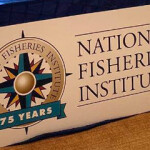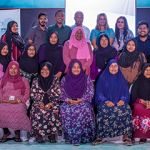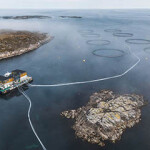The last frontier: The challenges ahead for Alaskan mariculture
This is part 2 of the "Last Frontier" series, exploring the work that needs to be done in order to meet the goals of the Alaska Mariculture Initiative. Part 1 provided a history and commercial overview of Alaska’s new initiative to grow state mariculture efforts into a billion-dollar industry.
John Kiser lives on a remote island in southern Alaska, 60 miles from Ketchikan, the nearest town large enough to show up on a map. The conditions there are perfect for farming oysters, a lifestyle Kiser turned to in 2008 when he founded Rocky Bay Oysters, following a 30-year career in the military.
The straight-talking Kiser loves what he does, and he boasts with pride that he grows some of the best-tasting oysters in the world. But when asked whether he would recommend his line of work to others, Kiser hesitated.
“You get into this for the lifestyle, not the money,” he said. “The industry has too many obstacles to make it viable on a larger scale.”
Kiser said he grows between 4,000 and 6,000 dozen oysters annually, depending on how his crop has done, and sells them all without much trouble. Market demand isn’t what’s keeping his business – and mariculture in general – from blossoming in Alaska, he said.
“The industry is very difficult because the same reasons that make our waters so good for growing oysters also make it very hard to make a living: we’re remote,” Kiser said. “That means we face enormous transportation challenges and our workforce is limited.”
Kiser, a board member of the Alaska Shellfish Growers Association, is a big fan of the Alaska Mariculture Initiative, activated in late February by Gov. Bill Walker issuing Administrative Order 280, which created a task force with the ultimate goal of growing Alaskan mariculture into a billion dollar industry. He thinks it can identify obstacles inhibiting the growth of the state’s mariculture and can organize the industry to advocate for solutions both technical and political.
“I think a collective effort like that will benefit the industry enormously, if it’s done right,” he said.
Sam Rabung, aquaculture section chief for Alaska’s Department of Fish and Game, shares Kiser’s optimism when it comes to the Alaska Mariculture Initiative. Rabung isn’t sure what’s been holding mariculture back in Alaska, but he’s eager to dedicate time and resources to the effort.
“It’s a worthwhile endeavor. There are so many other areas of the world where mariculture activities have been a great benefit to the economy and people of those areas, so I think it’s certainly worth us taking a look into it to see if we can realize some of those benefits here,” he said. "We’ve had aquatic farming in Alaska since the late 1980s, but it’s been stagnant since then – it just hasn’t taken off. Why not? We’ve got some of the best waters in the world for it. It should be providing a larger portion of our economy. So part of what the task force needs to do is look at what’s holding it back. Are there things that can be done that can help overcome the hurdles?”
Rabung identified a few hurdles himself: Alaskan laws that prohibit the use of any marine stocks that are not local, and the favoritism of so-called “traditional uses” of marine areas. Those rules, combined with the state’s ownership of all marine areas within three miles of the coast, may have contributed to the throttling of Alaskan mariculture, he said.
“We jealously guard our natural resources, and we make sure any new project will not have a significant effect on our natural areas as they exist now – we take a ‘first, do-no-harm’ approach when it comes to permitting and project approvals,” Rabung said. “We also make sure any new activity is not going to have a significant effect on traditional uses such as boating, wild fishing, popular public areas or marine mammal haul-out areas. Farmers may consider those hurdles but that’s just our framework.”
Rabung said his state’s stand on using local stocks also limits what opportunities aspiring marine farmers can pursue.
“Our requirement on the use of local stocks revolves around our assumption that whatever is in our waters is well-adapted to those areas, and that bringing in [species] from outside is not necessarily good for the area,” Rabung said. “Our one exception is Pacific oysters. They don’t reproduce in Alaska, but we allow those to come in from out of state from approved sources, as long as they are certified by our pathologist to be disease-free.”
Another limitation for Alaskan mariculture is the ban on finfish farms, which Rabung said was created in the 1980s as the practice gained popularity in other parts of the world.
“Our salmon fishermen felt like it was just not a good idea for a number of reasons, mainly out of concern of harming the wild salmon stocks,” Rabung said. “Wild capture seafood was and is a very big, important piece of our economy and rather than take any chances it might be harmed, we just banned it in Alaska.”
While these obstacles might prove insurmountable in a smaller state, their impact is lessened in Alaska by the state’s sheer massiveness, Rabung said.
“We have plenty of space to expand mariculture,” he said. “There’s an awful lot of water out there well-suited to growing shellfish and aquatic plants that won’t face interference with any of our policies or rules we have on the books.”
Rabung said he sees great potential for growing oysters, mussels, clams and geoduck in Alaskan waters. A concept paper put together by the Alaska Fisheries Development Foundation also highlighted the potential for farming scallop, Dungeness and King crab, abalone, sea cucumbers, sea urchin and kelp.
The biggest problem Rabung sees inhibiting growth in Alaskan mariculture doesn’t have to do with rules, but with infrastructure – or rather, the lack of it. He mentions places like the Aleutian Islands, which he says are “perfect” for aquaculture, but notes the extreme remoteness of the islands may increase costs and logistics prohibitively.
Kiser, the oyster farmer, said a major obstacle for him is the limited infrastructure available to marine farmers in the state. There’s only one water testing lab in the state, and it’s located in Anchorage, 762 miles away. Once Kiser takes a sample, he only has 30 hours to get it to the lab.
“That can be a big challenge,” Kiser said. “Some satellite water testing labs would make it a lot easier for farmers to succeed.”
Kiser also mentioned the difficulty of finding employees who want to work at his remote farm for far less pay than they might be able to earn working a few months on a salmon or crab fishing boat.
“What we need to do is develop an apprenticeship program to help solve this workforce problem. I think we could solve it by opening up to students nationwide and by offering school credit as well as some cash in their pocket,” Kiser said. “The task force should also look into creating a path for those who want to learn the trade and eventually own their own farm.”
The start-up process is another difficult step, as Alaska’s unique environmental factors – from hungry sea otters and starfish to cold water temperatures that slow marine growth rates – can inhibit cash flow for those getting started.
Despite the numerous challenges, Kiser remains optimistic regarding the future of Alaskan mariculture, especially following the creation of the Alaskan Mariculture Initiative and the announced formation of the task force.
Gov. Walker is expected to announce the members of the task force soon and its first meeting is scheduled for either April or May. Its mandate requires it to present its recommendations by 1 March, 2018.
“As long as they include people who are actually involved in doing the farming, I think the task force can really do some good,” Kiser said. “We can definitely grow the number of viable farms and create a more organized presence in the state. That’s what I’d like to see – the growth of mariculture as a strong industry that employs a lot more people, earns money for coastal communities and keeps it in Alaska.”






Share